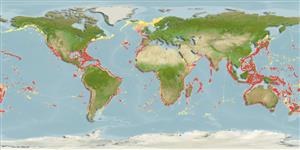Classification / Names
Common names from other countries
Main reference
Size / Weight / Age
Max length : 130 cm SL male/unsexed; (Ref. 6181); common length : 80.0 cm SL male/unsexed; (Ref. 6181)
Environment
Marine; benthopelagic; depth range 200 - 1200 m (Ref. 6181)
Climate / Range
Deep-water, preferred ?; 70°N - 47°S, 180°W - 180°E
Distribution
Probably distributed worldwide in tropical and subtropical seas except in eastern Pacific and northern Indian oceans. Large-sized individuals stray in cold-temperate waters off Iceland, Norway, northern Japan and southern New Zealand (Ref. 6181). Reported from 19°41'S, 79°11'W (Ref. 11892).
Countries | FAO areas | Ecosystems | Occurrences | Introductions
Short description
Dorsal
spines
(total): 20 - 22;
Dorsal
soft rays
(total): 19-24;
Anal
spines: 2;
Anal
soft rays: 18 - 21;
Vertebrae: 34 - 36. Body fairly elongate and strongly compressed. Mouth with fang-like teeth. The tips of both jaws with dermal processes. Gill rakers degenerated. Color is dark brown with violet tint; fin membranes black; margin of anus black (Ref. 6181).
IUCN Red List Status (Ref. 115185)
Threat to humans
Harmless
Human uses
Fisheries: minor commercial
More information
ReferencesAquacultureAquaculture profileStrainsGeneticsAllele frequenciesHeritabilityDiseasesProcessingMass conversion
Tools
Special reports
Download XML
Internet sources
Estimates of some properties based on models
Phylogenetic diversity index
PD50 = 1.0000 many relatives (e.g. carps) 0.5 - 2.0 few relatives (e.g. lungfishes)
Trophic Level
4.3 ±0.71 se; Based on food items.
Resilience
Low, minimum population doubling time 4.5 - 14 years (Preliminary K or Fecundity.)
Vulnerability
High to very high vulnerability (71 of 100)
Price category
